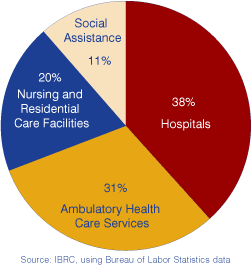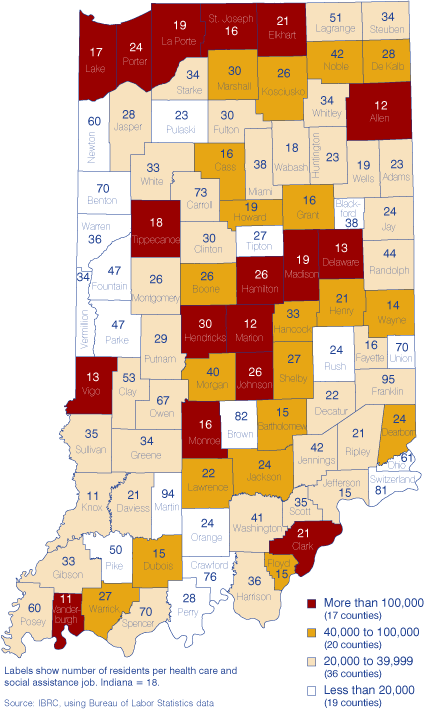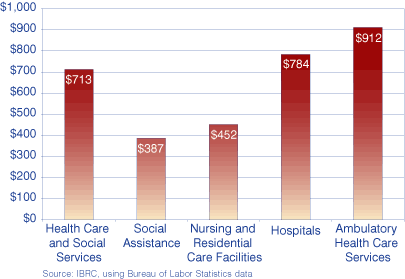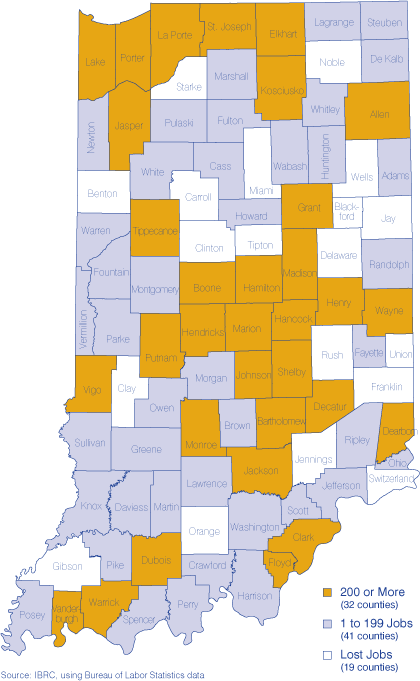Growth in Indiana's Health Care Sector
Many of the state's hot jobs are in the medical field, making health care and social assistance one of Indiana's fastest growing sectors. Between the third quarters of 2001 and 2005, Indiana added nearly 26,700 jobs in health care and social assistance. Tying with retail trade at 12 percent, it is the second-largest sector in the state (manufacturing ranks first at 20 percent). This article will utilize Covered Employment and Wages data to explore the health care and social assistance field, which employs over 348,000 Hoosiers statewide.
Overview
Figure 1 shows the four subsectors comprising the health care and social assistance sector. Though there are just 179 hospitals statewide, they employ 133,600 people. The ambulatory health care services subsector employs roughly 107,200 people in about 8,100 offices statewide (this includes physicians, dentists and other health practitioners' offices, as well as outpatient care centers, medical/diagnostic laboratories, and home health care services). Almost 68,000 Hoosiers are employed within Indiana's 1,082 nursing and residential care facilities. In addition, roughly 39,400 people work in the state's 2,235 social assistance establishments (which include individual and family services; food, housing and emergency services; vocational rehabilitation; and child daycare).
Figure 1: Subsector Employment as a Percent of Entire Sector, 2005:3

Jobs
At the county level, tiny Ohio County has less than 100 jobs in health care and social assistance, whereas Marion County has over 71,500. Since the size of the sector generally tends to coincide with the size of the population, how many people are there for each health care and social assistance job? Statewide, there are 18 residents for each job in the sector (see Figure 2). In Vanderburgh and Knox counties, that number drops to 11 residents. At the other end of the spectrum, both Martin and Franklin counties have over 90 people per health care and social assistance job (these are two of the 16 counties in the state without a hospital). The median number of residents per sector job equals 27 (meaning half of the counties have a higher number and half fall below it).
Figure 2: Population by County and Residents per Health Care Job, 2005:3

Wages
Overall, average weekly wages for the health care and social services sector equals $713. This exceeds the state average across all industries, which is $689 per week, and ranks about in the middle among all 20 NAICS sectors. Pike County has the lowest average weekly wage ($379), while the average exceeds $800 in both Marion County ($862) and Delaware County ($844). Statewide, wages between the subsectors run the gamut, from social assistance at $387 to ambulatory health care services at $912 per week (see Figure 3).
Figure 3: Health Care Sub-Sector Wages, 2005:3

Recent Changes
Since the third quarter of 2001, Indiana added 26,688 health care and social assistance jobs—a gain of 8.3 percent. This was the largest growth on a numeric basis and the second largest from a percent basis (trailing the administrative, support and waste management sector, whose growth exceeded 16 percent). Of the state's 92 counties, 73 experienced growth in the number of jobs in health and social assistance (see Figure 4). Focusing on percentages, the largest increases occurred in Newton, Owen and Hamilton counties, and the largest declines were found in Jennings, Union and Rush counties.
Figure 4: Health Care Job Growth, 2001:3 to 2005:3

Statewide, the average weekly wage for the health care and social assistance sector increased by $111 between 2001:3 and 2005:3. This was a gain of 18.4 percent, which tied with manufacturing as the fourth largest increase across all sectors. At the county level, the fastest wage growth was found in Owen County, with a gain of 91.2 percent (or $290 per week). Washington and Delaware counties rounded out the top three with gains exceeding 40 percent. Meanwhile, three counties—Brown, Hendricks and Knox—encountered wage declines of -11.2 percent, -2.2 percent and -0.9 percent, respectively.
At the subsector level, Indiana's nursing and residential care subsector grew the slowest at 10.5 percent (or $43 per week), while average wages in the hospital subsector grew the most at 25 percent (or $157 per week). Much of the subsector data for employment and earnings is suppressed at the county level, but a summary of what is available is shown in Table 1.
Table 1: Counties with Change in Health Care and Social Assistance Subsectors
Rachel Justis, Managing Editor
Indiana Business Research Center,
Kelley School of Business, Indiana University

